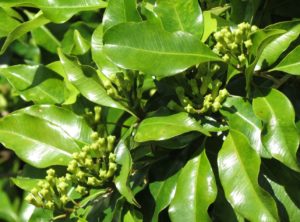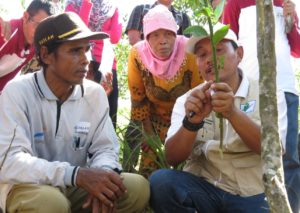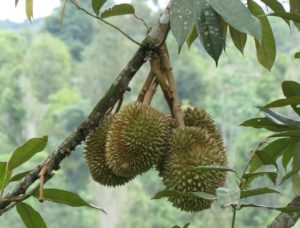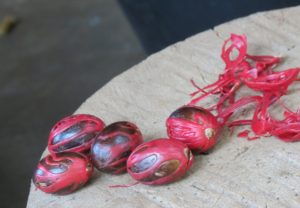
Photo by Endri Martini/ICRAF
A recently completed project in Sulawesi, Indonesia, illustrates how tree genetic resources can positively affect livelihoods.
The Agroforestry and Forestry in Sulawesi: Linking Knowledge with Action (AgFor Sulawesi) research in development project, which began in 2011, aimed to improve equitable and sustainable agroforestry and forestry-based livelihood systems through a focus on livelihoods, governance and sustainable environmental management.
One way it did so was by providing rural communities with better quality plant genetic material, improved on-farm management practices, marketing knowledge and capacity building in governance and environmental management.
As the project came to a close in March 2017, James Roshetko, FTA researcher from the World Agroforestry Centre (ICRAF), talked about using genetic resources to improve smallholders’ approaches.
“We started off by identifying the main species on farmers’ land, but also the species that the farmers were most interested in, the marketing opportunities and where farmers actually made the most money,” said Roshetko, who managed the project.
“The most important species were cacao, durian, cloves, rubber, nutmeg, coconut, black pepper, coffee, rambutan and teak,” he explained. They later included oranges, jackfruit and another timber called surian.
“A lot of those are commodity crops,” he added. “Even if the farmers have what we might call subsistence farming systems, they still need to sell something for cash in this day and age.”
The tradability of the products, whether globally or nationally, was key as a main income source for the participants.
Watch: Agroforestry and forestry in Sulawesi

Photo by Endri Martini/ICRAF
FTA researchers provided quality germplasm (seeds and seedlings) as the genetic resource, set up nurseries, and promoted species that could benefit people’s incomes.
After beginning in four districts, the project expanded to six more, thus covering 10 districts across South Sulawesi, Southeast Sulawesi and Gorontalo provinces.
“One of the first things that we would do was see if people were interested in developing tree nurseries. Before we were working in these areas, there were almost no nurseries at the farm level. In each district there might be one nursery,” said Roshetko.
“We introduced the concept that each farmer group could have its own nursery.”
As of September 2016, there were 308 nurseries in the 10 districts, he explained, which had produced 1.66 million high-quality seedlings.

Photo by Endri Martini/ICRAF
Of the seedlings, cloves accounted for 27%, while rubber was 24%, durian was 14%, pepper was 9%, cacao was 7% and nutmeg was 5%. This represented 86% of the total seedling production. Overall, seedlings of 60 different species were raised in the nurseries.
The farmers had the choice to become part of the AgFor Sulawesi project, Roshetko said. Project staff toured the districts, undertook community consultation and disseminated information about AgFor Sulawesi to arouse people’s interest.
Rather than financial incentives, Roshetko said the farmers were offered “knowledge, science and material to improve their own livelihoods.” They were told: “when we’re done, you’re going to be a better farmer and you’re going to be better off.”
Groups were not pushed to participate and a few indeed dropped out as the process continued. However, the majority stayed on. Over 630,000 people felt they had benefitted from the knowledge and technology introduced by the project, according to an impact assessment.
Following the project’s completion and with the support of government, though the nurseries may shrink in size, Roshetko expects that most will continue operating and raising quality seedlings for their own needs. One-third may function as commercial enterprises.
While much of the project was focused on development activities, there were still ample opportunities for research. The team looked at gender roles and economics, farmer agroforestry systems, cacao pests and diseases, as well as extension and nursery approaches, among others. As of March 2017, 19 peer-reviewed manuscripts had been published, with others under review.
Read also:
- AgFor project in Sulawesi helps to empower women in agroforestry
- Contagious ideas for smarter farms in Sulawesi
During AgFor Sulawesi’s lifespan, project staff published 18 booklets and fact sheets that provided farmers with guidelines and new knowledge on agroforestry systems. These were developed during farmer field schools and other project activities.
Participants in project trainings increased not only production but also their incomes through a greater understanding of the market.

Photo by Endri Martini/ICRAF
The effects were tangible, with Roshetko citing the example of a low-income woman who said that by increasing her agricultural production she was able to put her children through university.
With training a key aspect, the scientists introduced, for example, top grafting in cacao gardens as an alternative way to replace old trees that had become less productive. A top-grafted tree can return to full production sooner than a new seedling would reach full production.
Many of the farmers’ challenges came down to “simple management”, said Roshetko. “They may have been cacao farmers for years but these people never went to a training where their questions and priorities were the main focus.”
In line with FTA Flagship 1, AgFor Sulawesi used tree genetic resources to bridge gaps in production and promote resilience. The associated research is expected to improve genetic resources knowledge.
Some projects may lack opportunities for discussion or offer advice that farmers cannot afford to implement. AgFor Sulawesi, however, had an impact because staff encouraged participants to explain their specific situations, before addressing relevant problems. Roshetko said the approach was: “How can we help improve the situation from where the farmers started?”
Read also:
- Changing mindsets and landscapes in Sulawesi one district at a time
- What next for customary forests in Indonesia?
By Hannah Maddison-Harris, Communication and Editorial Coordinator, CGIAR Research Program on Forests, Trees and Agroforestry (FTA)
The Agroforestry and Forestry in Sulawesi: Linking Knowledge with Action (AgFor Sulawesi) project is mapped to FTA and funded by Global Affairs Canada and the CGIAR Fund Donors. It involved local communities, civil society groups, conservation organizations and universities to improve farmers’ incomes through agroforestry and natural resource management systems. AgFor Sulawesi was a collaboration between the Center for International Forestry Research (CIFOR), the World Agroforestry Centre (ICRAF), universities and non-governmental organizations (NGOs).
This research was supported by the Government of Canada, represented by the Minister of International Development, acting through Global Affairs Canada/GAC.











